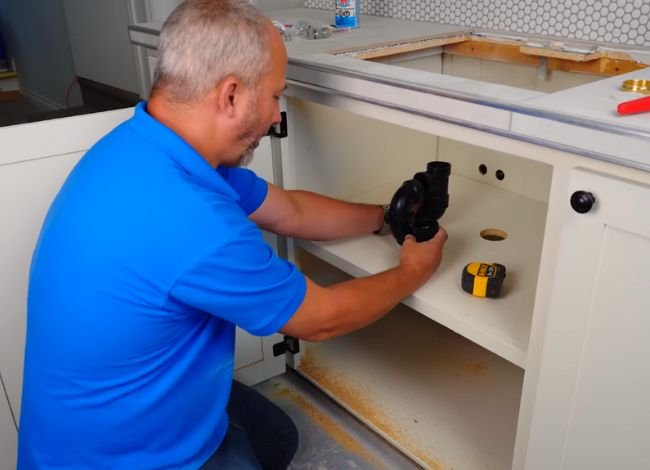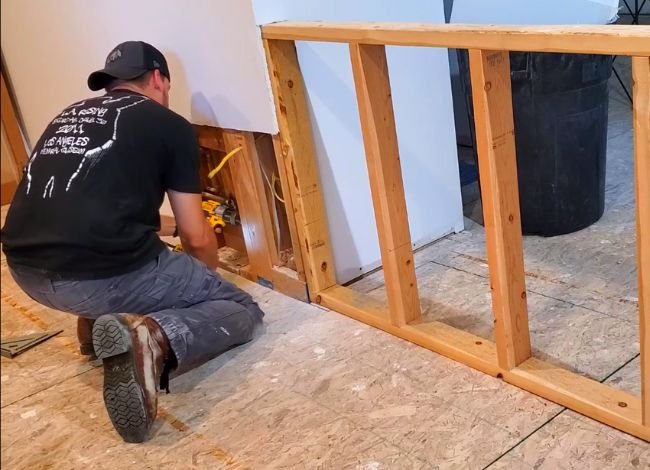Last Updated on January 20, 2024
The space required to install a kitchen sink will depend on the size and style of the sink, as well as the layout of your kitchen. It’s important to measure the space in your kitchen and consider the size and layout of your sink and other appliances to ensure that you have enough room for the sink to be installed properly. It may also be helpful to consult with a kitchen designer or professional plumber to determine the best size and style of the sink for your kitchen.
Space required to install a kitchen sink: Here are some general guidelines to consider:
Single bowl sinks: These sinks are typically 22 inches wide and 24 inches deep. They may require additional space for the plumbing and installation of the faucet and accessories.
Double bowl sinks: These sinks are usually wider than single bowl sinks, often around 33 inches wide. They may also require additional space for the plumbing and installation of the faucet and accessories.
Apron front sinks: Also known as farmhouse sinks, these sinks have a wide, exposed front and may be deeper than traditional sinks. They may require additional space for installation, as the front of the sink may extend beyond the countertop.
Undermount sinks: These sinks are installed under the countertop, with the rim of the sink hidden beneath the counter. They typically require less space for installation, as the sink does not extend beyond the countertop.
Moving kitchen sink plumbing over a few inches:
It’s important to note that moving kitchen sink plumbing can be a complex and time-consuming task. If you are not confident in your ability to do this work, it may be best to hire a professional plumber to handle the job.
- Before you start any work on the plumbing, be sure to turn off the main water supply to the kitchen. This will prevent water from flowing through the pipes while you work.
- To move the plumbing for the sink, you’ll need to disconnect the pipes that supply water to the sink and drain away waste water. This typically involves loosening the compression fittings or unscrewing the supply lines.
- Once the pipes are disconnected, you can remove the sink from the countertop. Depending on the type of sink you have, you may need to loosen mounting clips or screws to lift it off the counter.
- Once the sink is removed, you can reposition the plumbing to the desired location. This may involve cutting new holes in the countertop and installing new pipes to connect the sink to the water supply and drain.
- Once the plumbing is in place, you can install the sink by securing it to the countertop with mounting clips or screws. Be sure to connect the water supply and drain pipes to the sink and test the plumbing to ensure it is working properly.
How far can I move my kitchen sink?
The distance you can move your kitchen sink will depend on the layout of your kitchen and the plumbing system. Here are some factors to consider:
Plumbing
The plumbing system in your kitchen will determine the distance you can move your sink. If the plumbing is located near the current location of the sink, you may be able to move the sink a shorter distance. However, if the plumbing is located farther away, you may need to move the sink a greater distance to reach it.
Countertop
The size and layout of your countertop will also affect the distance you can move the sink. If you have a large countertop with plenty of space, you may be able to move the sink a greater distance. However, if your countertop is smaller or has a more complex layout, you may have less flexibility in terms of where you can position the sink.
Other appliances
The location of other appliances in your kitchen, such as the stove and refrigerator, may also impact the distance you can move your sink. You’ll want to ensure that there is enough space for all of your appliances to be installed and used comfortably.
Frequently Asked Questions
Q: How many inches can I move my sink plumbing without major renovations?
A: Typically, you can move your sink plumbing a few inches (up to 3-4 inches) without major changes. Going beyond that might require more extensive work, including adjusting the drain line and water supply lines.
Q: What tools will I need to move my kitchen sink plumbing?
A: Basic tools include a pipe wrench, adjustable wrench, hacksaw, PVC pipes and joints (if dealing with PVC plumbing), plumber’s tape, and possibly a drill if you need to make new holes for pipes.
Q: Do I need to turn off the water supply before starting the work?
A: Yes, always turn off the main water supply before beginning any plumbing work to avoid flooding and water damage.
Q: How do I deal with the drain pipe when moving the sink?
A: The drain pipe will need to be realigned with the new sink position. This may involve cutting and extending the pipe or adding angles with elbow joints to redirect the flow.
Q: Will moving my sink plumbing affect my dishwasher or garbage disposal?
A: It could, as these appliances are often connected to the sink’s plumbing. You may need to adjust or extend their connections as well.
Q: What are common mistakes to avoid when moving sink plumbing?
A: Common mistakes include not properly sealing connections, creating sharp bends in pipes that can lead to clogs, and not aligning the drain correctly, leading to poor drainage.
Q: How do I ensure the new plumbing doesn’t leak?
A: Ensure all connections are tight and properly sealed with plumber’s tape or putty. After installation, test the connections by running water and checking for any drips.
Q: Do I need to consider venting when moving my sink plumbing?
A: Yes, proper venting is crucial for the sink to drain correctly. If you move the sink significantly, you might need to adjust the venting pipes.
Q: What should I do if I encounter unexpected issues during the project?
A: If you face issues beyond your skill level, it’s wise to consult or hire a professional plumber. Mistakes in plumbing can lead to significant problems and expenses.
Q: Are there building codes I need to be aware of when moving plumbing?
A: Yes, plumbing work must comply with local building codes. Check with your local building department for any permits or regulations before starting the project.
Q: How long does it typically take to move kitchen sink plumbing?
A: The time can vary depending on the complexity of the move and your experience level. A simple shift can take a few hours, while more complex moves might require a full day or more.




